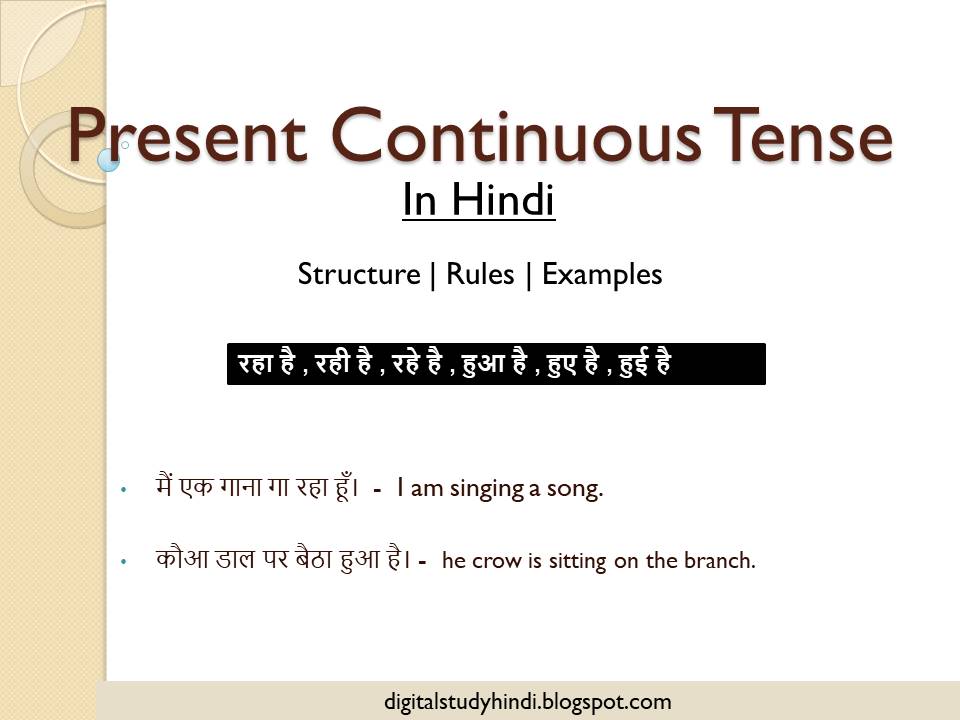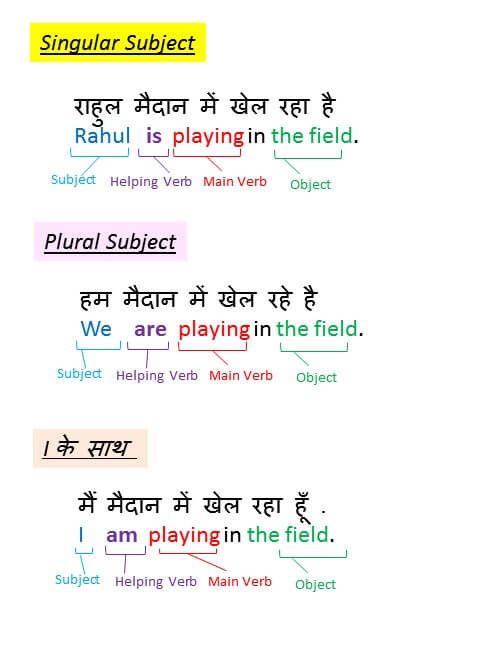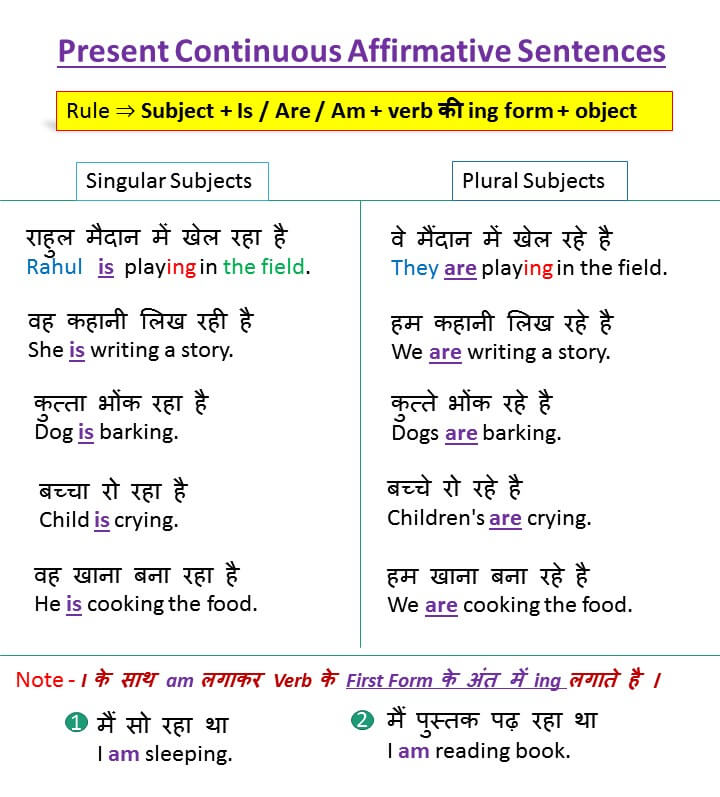Present Continuous Tense Translation Hindi to English
Table of Contents
आज हम Present Continuous Tense का प्रयोग करना सीखेंगे यहाँ पर आपको उदाहरण की सहायता से प्रेजेंट कंटीन्यूअस टेंस को सिखाने का प्रयास किया गया है ताकि आप अच्छे से समझ सकें सबसे पहले प्रेजेंट कंटीन्यूअस टेंस की पहिचान देख लेते है –
- Present Continuous Tense के वाक्यों के अंत में रहा है , रही है , रहे है तथा हुआ है , हुए है , हुई है आदि शब्द आते है
- इन वाक्यों में काम का जारी रहना पाया जाता है और काम के जारी रहने का समय नहीं दिया जाता है।

Present Continuous Tense Translation Rules
रहा है , रही है , रहे है , हुआ है , हुए है , हुई है
Present Continuous Tense के वाक्य को इंग्लिश में अनुवाद करने के नियम –
नियम 1 – He , She , It और एकवचन Noun Subject के साथ ‘is’ लगाकर Verb की ing form का प्रयोग करते है ।
नियम 2 – You ,We ,They और बहुवचन Noun Subject के साथ are लगाकर Verb की ing form लगाते है ।
नियम 3 – I के साथ am लगाकर Verb के First Form के अंत में ing लगाते है ।

| Subject | Helping Verb | Example |
| Singular | Is | He is playing |
| Plural | Are | You are playing. |
| I के साथ | Am | I am playing. |
Present Continuous Tense –
Affirmative Sentences ( सकारात्मक वाक्य )

Translation Rule- ⇒
Sub + Is / Are / Am + verb की ing form + obj
उदाहरण :-
( 1 ) मोहन एक पत्र लिख रहा है।
Mohan is writing a letter.
( 2) लड़कियां स्कूल जा रही है।
The girls are going to school.
( 3 ) वह मैदान में दौड़ रहा है।
He is running in the field
( 4 ) लड़के फुटबॉल का मैच खेल रहे है।
The boys are playing a football match.
( 5) मैं एक गाना गा रहा हूँ।
I am singing a song.
(6) तुम मथुरा से आ रहे हो।
You are coming from Mathura.
(7) कौआ डाल पर बैठा हुआ है।
The crow is sitting on the branch.
(8) मैं अपनी पुस्तक पड़ रहा हूँ।
I am reading my book.
Present Continuous Tense in Hindi –
2. Negative Sentences
Translation Rule-
⇒ Sub + is/am/are + not + verb की ing form + obj
उदाहरण :-
(1) वे घर नही जा रहे है।
They are not going to home.
(2) मैं अपनी पुस्तक नही पड़ रहा हूँ।
I am not reading my book.
(3) मोहन एक पत्र नही लिख रहा है।
Mohan is not writing a letter
(4) लड़कियां स्कूल नही का रही हैं।
The girls are not going to school.
(5) वह मैदान में नही दौड़ रहा है।
He is not running in the field.
(6) मैं गाना नहीं गा रहा हूँ।
I am not singing a song.
(7) राम मैदान में नही खेल रहा है।
Ram is not playing in the field.
(8) वे रेलगाडी की प्रतीक्षा नही कर रहे है।
Read this – Present Perfect Continuous tense
They are not waiting for train.
3. Interrogative Sentences
Translation Rule-
⇒ Is / Are / Am + Sub + { not } + verb मे ing form + obj
उदाहरण : –
(1) क्या वह स्कूल का चपरासी नही है ?
Is he, not the school peon?
(2) क्या आज तुम स्कूल नही जा रहे हो ?
Are you not going to school today?
(3) क्या मोहन एक पत्र नही लिख रहा है ?
Is Mohan not writing a letter?
(4) क्या मैं एक पत्र लिख रहा हूँ ?
Am I writing a letter?
(5) क्या राम मैदान में खेल रहा है ?
Is Ram playing in the field?
(6) क्या वे घर जा रहे हैं ?
Are they going home?
(7) क्या कौआ डाल पर बैठा हुआ है ?
Is the crow sitting on the branch?
(8) क्या तुम मथुरा से आ रहे हो ?
Are you coming from Mathura?
Read This- Present Perfect tense
4.Double Interrogative Sentences
Translation Rule-
⇒ Why / when / who / how etc. + Is / are / am + Sub + (not) + obj
उदाहरण: –
(1) तुम वहाँ क्यों जा रहे हो ?
Why are you going there?
(2) तुम कमरे मे क्या कर रहे हो ?
What are you doing in the room?
(3) मोहन पत्र क्यो नही लिख रहा है ?
Why is Mohan not writing a letter?
(4) वे कहाँ जा रहे हैं? Where are they going?
(5) कौआ डाल पर कहाँ बैठा हुआ है ?
Where is the crow sitting on the branch?
Note – How many , How much , Whose के साथ उनसे सम्बन्धित noun भी लगाते हैं। जैसे – कितनी लड़कियां ड्रामा में भाग ले रही है ? How many girls are taking part in the drama ?
Present Continuous Tense Exercise in Hindi (Affirmative सकारात्मक वाक्य )
- सुरेश दिल्ली जा रहा है।
- वह अपना पाठ याद कर रहा है।
- गौरव सो रहा है।
- अजय गाना गा रहा है।
- सोहन एक पत्र लिख रहा है।
- वरुण नहा रहा है।
- राहुल के पिताजी कार चला रहे है।
- मेरा दोस्त स्कूल से आ रहा है।
- तुम एक अच्छा काम कर रहे हो।
- मैं खाना बना हूँ।
English Translation:
- Suresh is going to Delhi.
- He is learning his lesson.
- Gaurav is sleeping
- Ajay is singing a song.
- Sohan is writing a letter.
- Varun is bathing
- Rahul’s father is driving the car.
- My friend is coming from school.
- You are doing a great work.
- I am cooking food.
Present Continuous Tense Exercise In Hindi (Negative Sentences नकारात्मक वाक्य )
- वह खाना नहीं बना रही है।
- रोहित के पापा ऑफिस नहीं जा रहे है।
- गौरव सो नहीं रहा है।
- अजय गाना नहीं गा रहा है।
- सोहन एक पत्र नहीं लिख रहा है.
- मैं टिकटोक वीडियो नहीं देख रहा हूँ।
- मैं pubg नहीं खेल रहा हूँ।
- तुम पार्टी में नहीं जा रहे हो।
- उसके पिताजी चुनाव नहीं लड़ रहे है।
- रोहित क्रिकेट खेलने नहीं आ रहा है।
English Translation:
- She is not cooking the food.
- Rohit’s father is not going to the office.
- Gaurav is not sleeping.
- Ajay is not singing a song.
- Sohan is not writing a letter.
- I am not watching tik tok video.
- I am not playing Pubg.
- You are not going to party.
- His father is not contesting the election.
- Rohit is not coming to play cricket
Present Continuous Tense Exercise In Hindi ( Interrogative Sentences प्रश्नवाचक वाक्य )
- क्या तुम पढ़ाई कर रहे हो। ?
- क्या उसका भाई कार चला रहा है ?
- क्या सुरेश एक अच्छा लड़का है ?
- क्या वह खाना बना रही है ?
- क्या सोहन पत्र लिख रहा है ?
- क्या अजय के पिताजी ऑफिस जा रहे है ?
- क्या मीणा गीत गा रही है ?
- क्या सुरेश दिल्ली जा रहा है ?
- क्या गौरव सो रहा है ?
- क्या रोहित क्रिकेट खेलने आ रहा है ?
English Translation:
- Are you studying?
- Is his brother driving a car?
- Is Suresh a good boy?
- Is she cooking the food?
- Is Sohan writing a letter?
- Is Ajay’s father going to the office?
- Is Meena singing a song?
- Is Suresh going to Delhi?
- Is Gaurav sleeping?
- Is Rohit coming to playing cricket?
Present Continuous Tense Exercise In Hindi ( Interrogative Negative Sentences नकरात्मक प्रश्नवाचक वाक्य )
- क्या तुम पढ़ाई नहीं कर रहे हो ?
- क्या उसका भाई गाड़ी नहीं चला रहा है ?
- क्या सोहन खाना नहीं खा रहा है?
- क्या गौरव सो नहीं रहा है ?
- क्या रोहित क्रिकेट खेलने नहीं आ रहा है ?
- क्या मीणा गीत नहीं गा रही है ?
- क्या आज तुम स्कूल नहीं जा रहे हो ?
- क्या तुम मथुरा नहीं जा रहे हो ?
- क्या राम मैदान में नहीं खेल रहा है ?
- क्या हरीश हमारे साथ खेलने नहीं आ रहा है ?
English Translation:
- Are you not studying?
- Is his brother not driving?
- Is Sohan not eating the food?
- Is Gaurav not sleeping
- Is Rohit not coming to play cricket?
- Is Meena not singing a song?
- Are you not going to school today?
- Are you not going to Mathura?
- Is Ram not playing on the ground?
- Is Harish not coming with us to play?
Present Continuous Tense Exercise in Hindi ( Double Interrogative Sentences प्रश्नवाचक वाक्य [कब , कहाँ कैसे आदि शब्द हो ] )
- तुम कहाँ जा रहे हो ?
- सुरेश दिल्ली क्यों जा रहा है ?
- रोहित हमारे घर कब आ रहा है।
- तुम इस कमरे में क्या कर रहे हो।
- गौरव कहाँ जा रहा है।
- अजय कहाँ सो रहा है।
- तुम कहा से आ रही हो।
- तुम मथुरा क्यों जा रहे हो।
- तुम्हारा दोस्त क्या खेल रहा है।
- हरीश वहां क्यों जा रहा है।
English Translation:
- Where are you going?
- Why is Suresh going to Delhi?
- When is Rohit coming to our house?
- What are you doing in this room?
- Where is Gaurav going?
- Where is Ajay sleeping?
- Where are you coming from?
- Why are you going to Mathura?
- What is your friend playing?
- Why is Harish going there?
English Translation:
Verb में ing लगाने के नियम
नियम 1 :- जिन Verb का अंतिम अक्षर ‘e ‘ है उनमें ing लगते समय ‘e ‘ हटा दी जाती है। जैसे –
- Come – Coming
- Give – Giving
- Make – Making
- Take – Taking
- Write – Writing
- Shake – Shaking
- Live – Living
- Save – Saving
नियम 2 :- जिन verbs के अंत में कोई एक ही व्यंजन ( Consonant ) और उससे पहले कोई एक ही स्वर (Vowel ) ( a ,e ,i ,o , u ) हो तो इसे शब्दों में ing लगते समय अंतिम अक्षर double हो जाता है।. जैसे –
- Stop – Stopping
- Sit – Sitting
- Cut – Cutting
- Shut –Shutting
- Put – Putting
- Run – Running
नियम 3 : – जिन Verb के अंत में y या ll हो उनमें ing लगाते समय y या ll नहीं हटाये जाते है । जैसे –
- Cry – Crying
- Buy – Buying
- Fly – Flying
- Kill – Killing
- Call – Calling
- Sell – Selling
- Tell – Telling
- Play – Playing
नियम 4 : – जिन Verbs के अंत में कोई व्यंजन ( Consonant ) हो और उससे पहले दो Vowels हो तो ‘ing‘ लगाते समय अंतिम Consonant Double नहीं होता है । जैसे –
- Read – Reading
- Weep – Weeping
- Meet – Meeting
- Sleep – Sleeping
- Beat – Beating
- Wait – Waiting
- Keep – Keeping
- Hear – Hearing
- Bear – Bearing
नियम 5 :– जिन Verbs के अंत में ‘n‘ होता है उससे पहले कोई भी Vowels (a,e,i,o,u) हो तो अंतिम अक्षर ‘n‘ double नहीं होता है । जैसे –
- Open – Opening
Exceptions
- Begin – Beginning
- Overrun – Overrunning
- Can – Canning
- Run – Running
- Ban – Banning
- Spin – Spinning
- Win – Winning
- Fan – Fanning
- Pin – Pinning
- Sun – Sunning
- Tan – Tanning
- Din – Dinning
नियम 6 :- जिन Verbs के अंत में ‘ie‘ हो तो उनमें ing लगाते समय ‘ie’ y में बदल जाता है । जैसे –
- Lie – Lying
- Die – Dying
- Tie – Tying
नियम 7 :- जिन Verbs के अन्त में ee , ye होते है , उन शब्दों में ‘ing‘ लगाते समय अंतिम e नहीं हटाते है। जैसे –
- See – Seeing
- Dye – Dyeing
- Agree – Agreeing
- Flee – Fleeing
- Wee – Weeing
Exercise 1.0
Present Continuous Tense पर आधारित कुछ वाक्य
- कमला गाना गा रही है।
- ये शरारती बालक अपना समय नष्ट कर रहे है।
- वे यात्री रेलगाड़ी की प्रतीक्षा कर रहे है।
- क्या हमारे कॉलेज के विद्यार्थी मैच नहीं खेल रहे है।
- क्या सुनार सोने के जेवर नहीं बना रहा है।
- रोहित अपनी परीक्षा की तयारी कर रहा है।
- ये लड़कियां बड़े ध्यान से गाना सुन रही है।
- भिकारी भीक मांग रहा है।
- क्या मीना अपनी गुडियो से नहीं खेल रही है।
- क्या तुम आज मुंबई नहीं जा रहे हो।
- तुम कौन से पुस्तक पड़ रहे हो।
- भिकारी क्यों भीक मांग रहा है।
Story in Present Continuous Tense in Hindi
दोस्तों इस स्टोरी में present continuous tense के साथ-साथ अन्य टेंस भी देखने को मिलेंगे हम उनके उपयोग पहले ही सिखा चुके है .
Story In Hindi – हमारा देश महान है। शताब्दियों तक हमारा इतिहास गौरवपूर्ण रहा है। केवल पूर्व के देश ही नहीं बल्कि पक्षिम के सभी देश भी हमारी प्राचीन संस्कृत की छाप लिए हुए है। हमारे दर्शन और साहित्य ने पक्षिमी जीवन धारा को काफी प्रभावित किया है। आज हम उन्नति के दौर में अग्रसर होने का प्रयास कर रहे है। हम सब का कर्तव्य है कि देश को सेवा में सब कुछ निछावर कर दें। हमें जाति , धर्म और प्रान्तीयता के भेदो को भूल जाना चाहिए। हमें याद रखना चाहिए कि यदि हमारे देश की उन्नति होगी तो हमारा भविष्य भी शानदार होगा।
Translation of this Story – Our country is great. Our history has been glorious for centuries. Not only the countries of the East but all the countries of the East have also got the impression of our ancient Sanskrit. Our philosophy and literature have greatly influenced Western lifestream. Today we are trying to get ahead in the era of progress. We all have a duty to leave everything in service to the country. We should forget the differences between caste, religion, and provinciality. We should remember that if our country grows, our future will also be great.
➤ Present Indefinite Tense In Hindi
➤ Present Continuous Tense In Hindi
➤ Present Perfect Tense In Hindi
➤ Present Perfect Continuous Tense In Hindi’
➤ Past Indefinite Tense In Hindi (Simple Past )
➤ Past Continuous Tense In Hindi
➤ Past Perfect Tense In Hindi
➤ Past Perfect Continuous Tense In Hindi
➤ Future Indefinite Tense In Hindi
➤ Future Continuous Tense In Hindi
➤ Future Perfect Tense In Hindi
➤Future Perfect Continuous Tense In Hindi

Can you please explain, when to use 'have' and 'has'
Hoe i am solve these type of Q.C at what time
https://digitalstudyhindi.blogspot.com/2018/01/has-have-had-in-hindi.html
Super
Hello sir thanks for sharing the update, When I read your blog, I found what I need and you inspired me to write more about the same article So I request to you please visit my blog and tell me if there any updations I mentioned my blog link please visit at once thankyou
https://englishmesikho.com/present-perfect-tense-and-their-example/